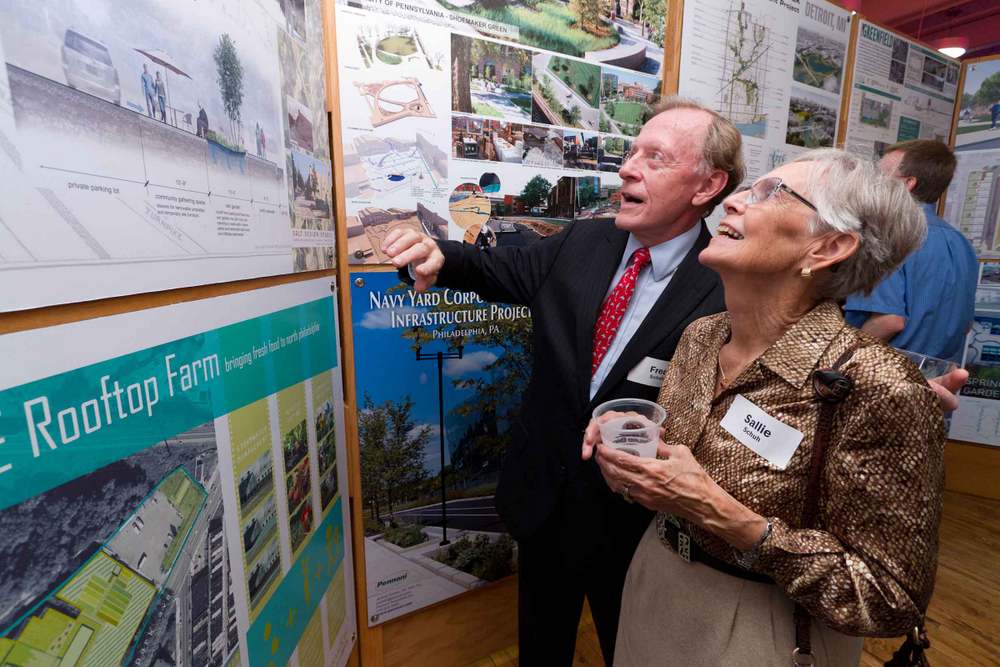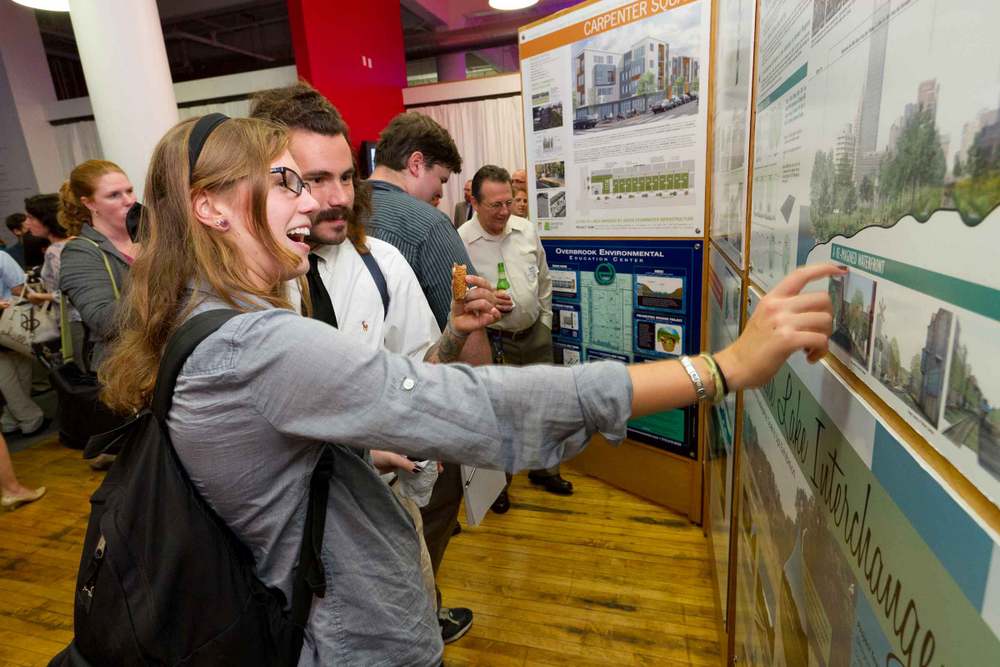
Attendees view an exhibit of green infrastructure designs before the Infill Philadelphia: Soak It Up! design competition launch.
Photo credit: Mark Garvin
Throughout much of the U.S., there is a lack of familiarity with low impact development (LID) in the engineering and design community. LID design competitions give engineers, developers, landscape architects, and others a chance to gain experience with LID in a low-risk environment. Competitions can also break down perceived barriers to LID — such as performance and cost — and give the development and permitting community a chance to see LID benefits on the ground.
On May 16 and 17, the Water Environment Federation (WEF) hosted a 2-day workshop on LID design competitions that was funded by a Chesapeake Bay Trust grant. The workshop brought together representatives from both organizations with experience and those with an interest in holding such competitions. The goal was to address barriers and provide guidance for those who want to host an LID design competition in their region.
Robert Adair, steering committee chair of the Houston Land/Water Sustainability Forum (HLWSF), provided insight from the 2010 Houston LID Design Competition, which has served as a model for many other competitions. The following is an overview of how to host an LID design competition based on input from the workshop. WEF will be releasing a more extensive white paper on the topic in late summer.
Four stages of the LID design competition
LID design competitions vary in their objectives, scale, and timing. They can be specific to a neighborhood, city, or region or be statewide, like the Virginia LID Design Competition. Some, like the Houston competition, are as quick as 10 months start to finish. However, there are four essential stages for each competition.
1. Prelaunch
Define the objectives. Low impact development is an approach that focuses on decentralized infiltration- and retention-based practices, rather than large downstream facilities. Before the competition, it is important to determine how LID fits the region’s objectives and how a competition can further those goals. Common goals include changing ordinances, raising awareness of upcoming regulations, and increasing experience among members of the development community.
Form a steering committee. Building a strong, interdisciplinary steering committee is important, because members may be involved in promoting the event, providing contacts, securing prize money, and encouraging participation on design teams. Members should include people who are influential and knowledgeable about the local community, such as key developers, city and county staff, and local trade-association leaders. Steering committee members should be prepared to meet regularly leading up to the competition launch.
Set up program management. In Houston, a subcommittee of the steering group did the detailed planning and met at least once per week. Volunteer time and roles may differ for staff-driven competitions like the San Antonio LID Design Competition, for which the finals event is approaching in early June. The Infill Philadelphia: Soak It Up! design competition was unique in that the organizing entity, the Community Design Collaborative, was selected by the Philadelphia Water Department through a request for proposals.
Select properties. It is important to obtain real properties that could be developed with LID. Select sites based on specific goals. For example, it may be appropriate to select sites that are representative of local conditions or common development types. By focusing on problem development types, the competition could show that LID is applicable even under challenging site conditions.
Before approaching a developer for a design challenge property, research the development company to determine which aspects of the competition will align with their interests. One advantage is that many teams would put substantial creative effort into developing a winning LID design that is more marketable, environmentally friendly, and less costly to execute than traditional design.
Create competition rules. Goals and objectives should be reflected in the design criteria. Examples include ensuring that the project is implementable and including a life-cycle cost comparison between LID and traditional stormwater infrastructure. Workshop participants advised using standardized criteria for project costs and estimated benefits, so that judges aren’t comparing gallons captured to greened acres. This also helps even the playing field. See examples of competition rules:
Secure funding. High dollar cash prizes draw attention to the competition and differentiate from typical design competitions. However, based on a survey of the LID workshop participants, 80% said that lack of funding for the competition winners is one of the primary barriers. Adair suggests talking to high-level staff at local trade organizations and development firms. Clean Water Act Sec. 319 funds and foundations are other potential funding sources. Other expenses include marketing costs, expert-judging travel, and finals event costs. While registration fees and finals event tickets can provide sufficient income, funding may be needed ahead of time to underwrite the event. Beyond funding for the prize money, the Houston competition covered all other expenses.
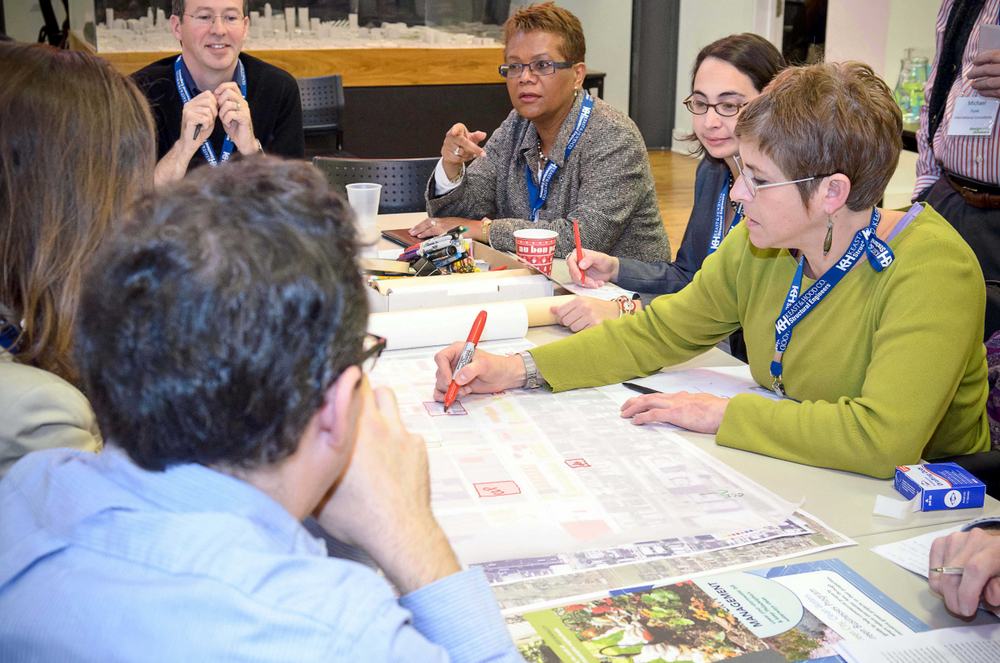
Holding LID events before and during the competition can increase competition participation, LID knowledge, and excitement. These images from Infill Philadelphia show a green infrastructure design exhibition (top) and a Design Charrette (bottom).
Photo credit: Mark Garvin
2. The launch
Marketing. Schedule a kick-off event with an influential speaker to make a splash and get media involvement. For its competition, Philadelphia hosted a series of events, including an exhibition with LID projects from across the U.S., to inspire people before the competition.
Send press releases to local news outlets for major milestones and design team registration updates. Announcing who is competing serves a twofold purpose of marketing and peer-pressuring others to get involved. A blog, website, and e-newsletter are additional ways to reach out to the community. Utilize stakeholder mailing lists, and pass news along through national organization outlets, such as trade magazines and association websites.
Encouraging participation. Pressure from peers and local government was significant in getting participants in the game, Adair said. Government officials from the city and county levels should convey the internal significance of the design competition. Also, draw on the influence of the steering committee to increase participation.
Make participation easier by setting up a team/teammate finder. Houston and others used Google Groups for this. Also, maintain a level playing field by posting all participant questions and the answers online.
3. Judging and the finals event
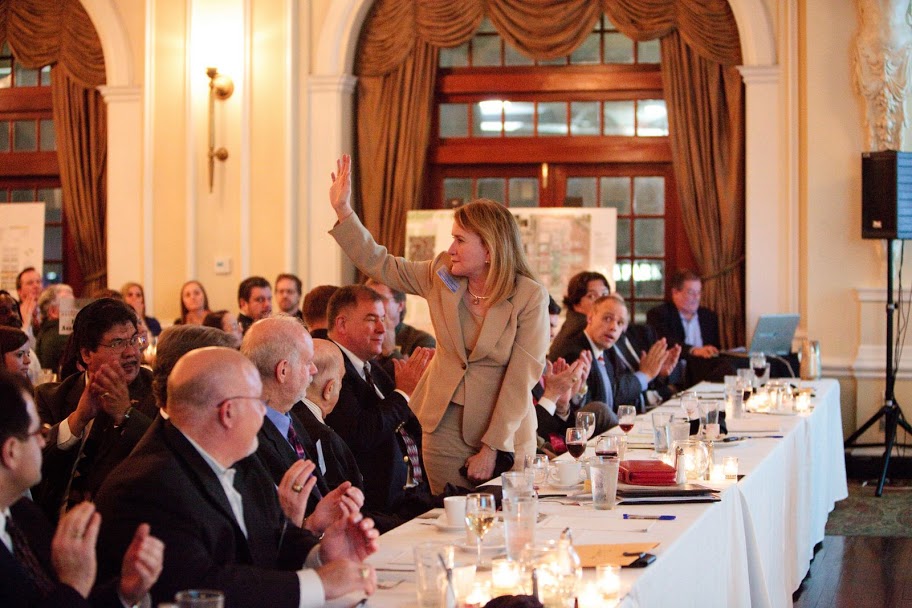
Commissioner Sylvia R. Garcia, part of the finals panel jury, stands to greet the audience at the Houston Low Impact Development Design Competition.
Photo credit: Eric Hester
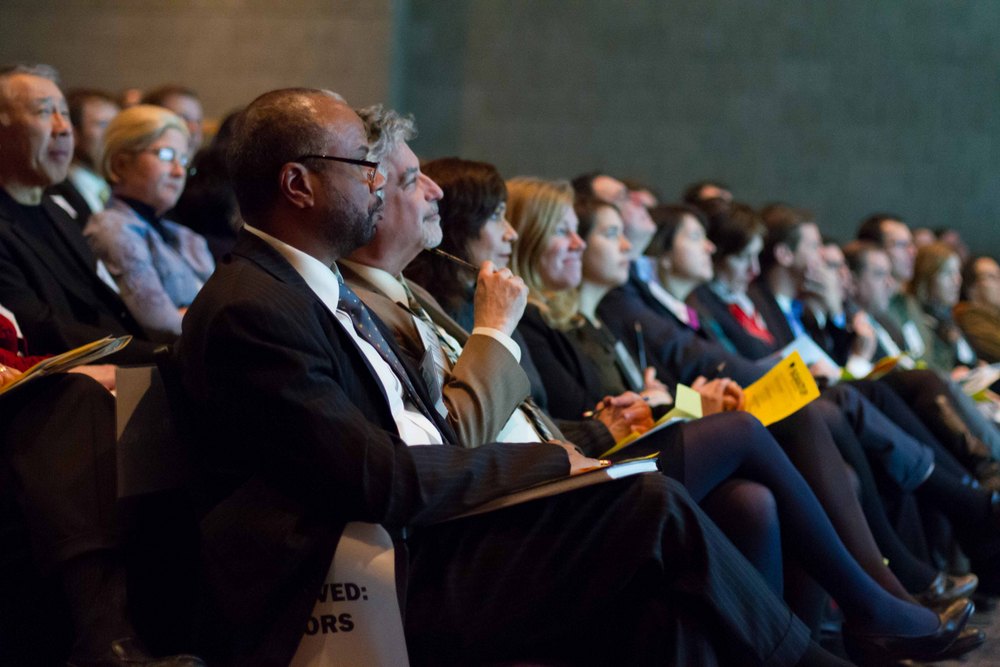
At the Infill Philadelphia: Soak It Up! design competition finals event, attendees watch as teams present their proposed designs.
Photo credit: Mark Garvin
Collecting the materials. HLWSF made it clear that participants were not giving up rights to intellectual property but that the organization would have the right to use the materials submitted for promotion. The San Antonio Land/Water Sustainability Forum collected short descriptions and feature images for press releases, along with longer pieces to use online and during judging. In addition, all competitions required teams to submit foam core boards for display at the finals event and for future exhibits. To ensure the anonymity of design team members during expert judging, it is important that the submitted materials have no identifying marks.
Expert panel. In most competitions held to date, 80% of the total final scores came from the expert judges panel, while the finals jury accounted for 20%. Judges received submissions 1 month in advance and were given a scoring sheet with key criteria and a point system.
Judges represented an even mix of key local influencers with expertise in LID and traditional infrastructure. According to Adair, serving as a judge can be a very subtle but strong positive influencer for those who either have doubts or know little about LID. In addition, high-profile judges can attract participation on design teams.
The finals event. Make the finals event the place to be, Adair said, complete with a fancy location, meet-and-greet time, and fast-paced presentations. Use a videographer and photographer to capture future marketing materials.
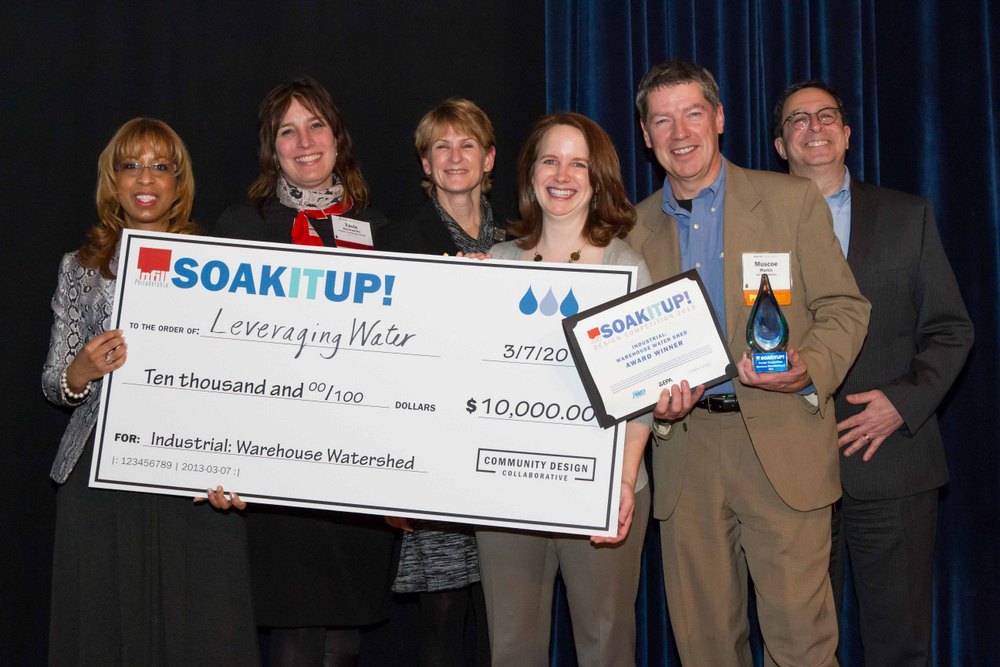
One of the winning teams from the Infill Philadelphia: Soak it Up! design competition.
Photo credit: Mark Garvin
Finalist presentations. In the Houston competition, finalists were given 3 weeks to prepare for the finals event. On the night of the event, finalists gave 7-minute lightning presentations that resembled a pitch to developers. “We wanted groups that are good at selling what they are bringing to the table,” Adair said. To ensure that presentations lasted only 7 minutes, Philadelphia finalists had to use automatic timing of 20 seconds per slide.
Finals panel. According to Adair, the ideal finals panel is made up of well-known local developers, politicians, and public agency leadership. “These jury members promote your competition, the results, and advocate about LID after the fact,” Adair said.
Also, make sure to create a simple jury scorecard to easily tabulate results during the finals event.
4. After the competition
Create a ripple effect. Competitions can show that LID is cost-effective and confers a host of other benefits. Be sure to capitalize on these lessons learned. Continue to host events that promote LID and showcase the design teams’ work. Share the experience at conferences and via other outlets.
Gather feedback from design teams and judges, and track the spread of LID in the community. HLWSF hosted a 1-year anniversary party for those who participated. The organization found that about 60% of participants had opportunities to work on LID during the last year, and about 70% of participant’s clients were receptive to LID.
The competition has the power to not only change mindsets but turn participants into advocates. According to Adair, the two most conservative engineering firms in Houston now promote LID designs first, and hundreds of LID-based projects are under way in the Houston area.
Break down barriers to LID. After the Houston competition, HLWSF organized a series of collaborative workshops involving the design community, developers, and city and county staff that examined impediments to LID in Houston-area design and development codes. The end result was the Harris County Low Impact Development and Green Infrastructure Design Criteria for Stormwater Management. The document outlines simple, performance-based LID design criteria and a collaborative and expedited permitting process for LID-based projects. The goal, Adair said, is to get as much LID on the ground as possible during the next 3 to 5 years. Every stage of the process will provide opportunities for learning and collecting data to develop more-formal code.

